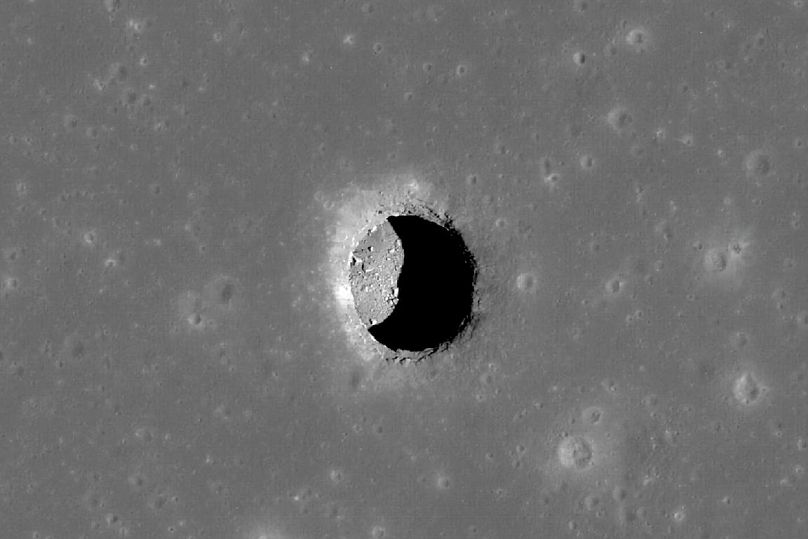Shady areas within pits and caves on the Moon that always hover around a comfortable 17°C could soon allow future astronauts to live on the Moon.
Lunar pits and caves could provide future human explorers with a safe haven on the Moon thanks to their Earth-like temperatures, a group of scientists has found.
A team led by planetary scientists at UCLA has discovered shady areas within pits on the Moon’s surface that always hover around a comfortable 63 degrees Fahrenheit (17°C) – meaning future astronauts might have 99 problems but staying cool won’t be one.
These pit craters, and the caves to which they may potentially lead, would make safer, more thermally stable base camps for lunar exploration and long-term habitation than the rest of the Moon’s surface, which heats up to 260 degrees (126.6°C) during the day and drops to 280 degrees below zero at night (-173.3°C).
First discovered in 2009, about 16 of more than 200 lunar pits found are probably collapsed lava tubes, according to lead author study Tyler Horvath, a UCLA doctoral student in planetary science.
“We could be able to establish a long-term presence on the Moon sooner than may have otherwise been possible,” said Horvath, adding that two of the most prominent craters have visible overhangs that clearly lead to some sort of cave or void, and there is strong evidence that another’s overhang may also lead to a large cave.
Also found on Earth, lava tubes form when molten lava flows beneath a field of cooled lava or a crust forms over a river of lava, leaving a long, hollow tunnel.
When a lava tube collapses, it opens a pit that can lead into the rest of the cave-like tube.
Where it's almost always 'sweather weather'
Using processed images from the Diviner Lunar Radiometer Experiment – a thermal camera on NASA’s robotic Lunar Reconnaissance Orbiter – Horvath and his team were able to find that the temperature within the pits was almost always "sweater weather".
The research team focused on a roughly cylindrical 100-metre-deep depression about the length and width of a football field in an area of the moon known as the "Mare Tranquillitatis," and used computer modeling to analyse the thermal properties of the rock and lunar dust to measure the pit’s temperatures over a period of time.
They believe the shadowing overhang is responsible for the steady temperature, limiting how hot things get during the day and preventing heat from radiating away at night.
Meanwhile, the sunbaked part of the crater’s floor hits daytime temperatures close to 300 degrees (148.8°C), some 40 degrees hotter than the Moon’s surface.
"Because the Tranquillitatis pit is the closest to the lunar equator, the illuminated floor at noon is probably the hottest place on the entire Moon," said Horvath.
Back to the caves
A day on the Moon lasts nearly 15 Earth days, during which the surface is constantly bombarded by sunlight and is frequently hot enough to boil water, the report reads, while unimaginably cold nights also last about 15 Earth days.
Building bases in the shadowed parts of these lunar craters could allow scientists to focus on other challenges, like growing food, gathering resources for experiments, expanding the base, and above all, providing oxygen for astronauts.
The caves would also offer some protection from cosmic rays, solar radiation, and micrometeorites.
"Humans evolved living in caves, and to caves we might return when we live on the Moon," said study co-author David Paige, who leads the Diviner Lunar Radiometer Experiment.
However, inventing heating and cooling equipment that can operate under these conditions and producing enough energy to power it non-stop could prove an insurmountable barrier to lunar habitation. Solar power – NASA’s most common form of power generation – doesn’t work at night.
NASA said it currently has no plans to establish an exploration base camp on the Moon.












